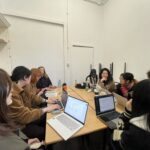Peer review is a valuable process that benefits me in both giving and receiving feedback. When I review my peers’ work, it helps me develop critical thinking skills, articulate my thoughts clearly, and engage with different perspectives. Providing constructive feedback allows me to analyze and reflect on ideas, which in turn helps me improve my own writing and curatorial thinking.
At the same time, receiving feedback from my peers is just as important. It gives me insight into how others interpret my work, highlights areas I may have overlooked, and encourages me to refine my approach. Seeing my work through someone else’s perspective often challenges my assumptions and pushes me to think more critically.
Here are two comments I wrote for Emily Geary’s blog:
- The title of the first blog post is: “A Change of Heart continued…”, A Change of Heart continued… – Emily Geary / Curating (2024-2025)[SEM2]
- Here is my comment:
Your project presents a compelling and deeply rooted exploration of Irish mythology, indigenous wisdom, and environmental concerns, particularly in relation to Ash Dieback. The intertwining of folklore with contemporary ecological issues adds a profound layer of meaning, making it not only relevant but also culturally significant.
One of the strongest aspects of your proposal is the use of site-specificity. Positioning the project in Athlone—considered the heart of Ireland—adds symbolic depth, reinforcing the sacred role of Ash trees in Irish tradition. Additionally, referencing Queen Meadhbh as the land’s protector enhances the connection between mythology and environmental conservation.
The inclusion of workshops and storytelling sessions through Seanachoiche is an excellent addition, fostering public engagement and reviving oral traditions. However, it might be worth considering whether these workshops could extend beyond storytelling—perhaps including guided walks, ritualistic planting of new Ash trees, or even interactive art sessions where participants could respond creatively to the themes of loss and renewal.
One area that might benefit from further exploration is the role of digital engagement. While you mention an online archive, expanding on how it will function (e.g., including audio recordings of folklore, interactive maps, or a digital forum for shared stories) could make the exhibition’s reach more enduring.
- The title of the second blog post is: Seating arrangements, Seating arrangements – Emily Geary / Curating (2024-2025)[SEM2]
- Here is my comment:
Your reflections on Claire Jackson’s talk at Tramway provide a compelling insight into the interplay between curators, estates, and exhibition layouts—something that is often overlooked. It’s particularly interesting that you challenge the assumption that curators have full autonomy over the final arrangement. The negotiation process you mention adds an important dimension to curatorial practice, highlighting how multiple stakeholders shape an exhibition.
Your reference to Fran Cottell’s Pentagon Petal adds another layer to this discussion. The idea of a modular, multi-functional structure that accommodates simultaneous conversations is particularly relevant to your project. It suggests that seating is not just functional but can be conceptually and socially significant, shaping the way people interact within an exhibition.
As you explore seating arrangements for your installation of ash sculptures, you might consider how form affects function. Should the seating be strictly circular to reflect Irish storytelling traditions? Or should it be more open-ended, like the continuous bench or Cottell’s Pentagon Petal, to encourage a broader range of interactions?
I would like to say that your post is thoughtful and well-connected to both curatorial practice and your own project. I look forward to seeing how your exploration of seating design shapes the final concept of your installation!
Here are two comments I wrote for Zihan Fu’s blog:
- The title of the first blog post is: “Spells, Wild Spaces, and the Reconstruction of Intimacy—From Anne Hardy’s Survival Spells to Curating Intimacy in the Globalized Era”, Spells, Wild Spaces, and the Reconstruction of Intimacy—From Anne Hardy’s Survival Spells to Curating Intimacy in the Globalized Era – Zihan Fu / Curating (2024-2025)[SEM2]
- Here is my comment:
Your post presents a deeply engaging and intellectually rich exploration of intimacy, power structures, and curatorial intervention, weaving together theories from Anne Hardy, Homi Bhabha, and Claire Bishop to reframe exhibition-making as a dynamic, participatory process. Your concept of “critical intimacy”—where emotional experience serves as a means of exposing structural conditions—is particularly compelling, as it challenges traditional, sentimentalized notions of intimacy and instead positions it as an unstable, contested space.
he proposed shift in “Open or Closed?” from static relationship mapping to an interactive, spell-based engagement is an exciting development. Using sensor-based installations and material interactions (glowing threads, ambient noise, and sculptural elements) to materialize the fragility and tensions of intimacy makes for a much more immersive, sensorial experience. Your reference to cross-cultural acoustic compression—where the plastic-bag sculpture triggers the sound of Scottish bagpipes—is a particularly striking idea. This unexpected juxtaposition forces visitors to confront the weight of care, the friction of expectations, and the persistence of cultural memory, making intangible emotional labor physically and sonically present.
Your reflections demonstrate a refined shift from critiquing intimacy’s structure to an experimental, ritualistic curatorial approach. This transition—from observation to participatory “spellcasting”—reimagines exhibitions as sites that create, not just display, intimacy. I look forward to seeing how this evolves in your final framework.
- The title of the second blog post is: Curating Intimacy: Experimental Models and Critical Reflections, Week 3 Post – Zihan Fu / Curating (2024-2025)[SEM2]
- Here is my comment:
Your post thoughtfully explores the evolving concept of intimacy in your curatorial research. Initially focused on romantic relationships, your shift toward a broader understanding—including familial bonds, friendships, and even brief encounters between strangers—adds layers of complexity to your approach. Your recognition that intimacy is not just a personal experience but also shaped by social, cultural, and institutional frameworks strengthens your curatorial perspective, making it more expansive and critically engaged.
“Time Capsule of Intimacy” invites participants to contribute objects representing significant relationships, alongside letters to their future selves. This project cleverly explores the temporality of intimacy—which emotions endure, and which fade over time? Your reference to Sophie Calle’s Take Care of Yourself is relevant, as it similarly transforms personal experiences into public artifacts, raising the question: Does exhibiting intimacy strip it of its private essence?
“Silent Dialogues” borrows from Marina Abramović’s The Artist Is Present but reframes it within the context of non-verbal communication as a foundation of intimacy. Your questions—Can intimacy exist without language? Does presence alone establish a connection?—are compelling, as they challenge conventional ideas about how relationships are formed. This experiment could evoke a range of emotions in participants, from deep connection to discomfort, highlighting the tension between mutual engagement and the potential unease of forced emotional participation.
One possible avenue for further exploration is the cultural variability of intimacy. Western societies often emphasize individualized expressions of intimacy, while many Asian cultures prioritize collective and familial bonds. Could your exhibition introduce a cross-cultural perspective, encouraging audiences to reflect on the diverse ways intimacy is experienced across different societies?







